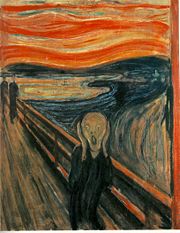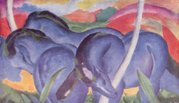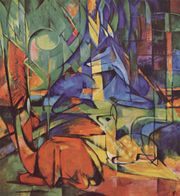Expressionism
2008/9 Schools Wikipedia Selection. Related subjects: Art
Expressionism is the tendency of an artist to distort reality for an emotional effect; it is a subjective art form. Expressionism is exhibited in many art forms, including painting, literature, theatre, film, architecture and music. The term often implies emotional angst. In a general sense, painters such as Matthias Grünewald and El Greco can be called expressionist, though in practice, the term is applied mainly to 20th century works.
Origin of the term
Although it is used as term of reference, there has never been a distinct movement that called itself "expressionism", apart from the use of the term by Herwald Walden in his polemic magazine Der Sturm in 1912. The term is usually linked to paintings and graphic work in Germany at the turn of the century which challenged the academic traditions, particularly through the Die Brücke and Der Blaue Reiter groups. Philosopher Friedrich Nietzsche played a key role in originating modern expressionism by clarifying and serving as a conduit for previously neglected currents in ancient art.
In The Birth of Tragedy Nietzsche presented his theory of the ancient dualism between two types of aesthetic experience, namely the Apollonian and the Dionysian; a dualism between the plastic "art of sculpture", of lyrical dream-inspiration, identity (the principium individuationis), order, regularity, and calm repose, and, on the other hand, the non-plastic "art of music", of intoxication, forgetfulness, chaos, and the ecstatic dissolution of identity in the collective. The analogy with the world of the Greek gods typifies the relationship between these extremes: two godsons, incompatible and yet inseparable. According to Nietzsche, both elements are present in any work of art. The basic characteristics of expressionism are Dionysian: bold colours, distorted forms-in-dissolution, two-dimensional, without perspective.
More generally the term refers to art that expresses intense emotion. It is arguable that all artists are expressive but there is a long line of art production in which heavy emphasis is placed on communication through emotion. Such art often occurs during time of social upheaval, and through the tradition of graphic art there is a powerful and moving record of chaos in Europe from the 15th century on the Protestant Reformation, Peasants' War, Spanish Occupation of Netherlands, the rape, pillage and disaster associated with countless periods of chaos and oppression are presented in the documents of the printmaker. Often the work is unimpressive aesthetically, but almost without exception has the capacity to move the viewer to strong emotions with the drama and often horror of the scenes depicted.
The term was also coined by Czech art historian Antonín Matějček in 1910 as the opposite of impressionism: "An Expressionist wishes, above all, to express himself....[An Expressionist rejects] immediate perception and builds on more complex psychic structures....Impressions and mental images that pass through mental peoples soul as through a filter which rids them of all substantial accretions to produce their clear essence [...and] are assimilated and condense into more general forms, into types, which he transcribes through simple short-hand formulae and symbols." (Gordon, 1987)
Visual artists
Some of the movement's leading visual artists in the early 20th century were:
- Germany: Heinrich Campendonk, Emil Nolde, Rolf Nesch, Franz Marc, Ernst Barlach, Wilhelm Lehmbruck, Erich Heckel, Otto Dix, Karl Schmidt-Rottluff, Ernst Ludwig Kirchner, Fritz Bleyl, Max Beckmann, Conrad Felixmüller, Carl Hofer, August Macke, Elfriede Lohse-Wächtler, Ludwig Meidner, Paula Modersohn-Becker, Gabriele Münter, Max Pechstein and Käthe Kollwitz.
- Austria: Egon Schiele and Oskar Kokoschka
- Russia: Wassily Kandinsky, Marc Chagall, Alexei Jawlensky and Natalia Goncharova.
- Lithuania: Mstislav Dobuzhinsky.
- Netherlands: Charles Eyck, Willem Hofhuizen, Jaap Min, Jan Sluyters,Vincent Van Gogh, Jan Wiegers and Hendrik Werkman
- Belgium: Constant Permeke, Gustave De Smet, Frits Van den Berghe, James Ensor, Floris Jespers and Albert Droesbeke.
- France: Georges Rouault, Gen Paul and Chaim Soutine
- Norway: Edvard Munch, Kai Fjell
- Mexico: Rufino Tamayo
- Switzerland: Carl Eugen Keel, Cuno Amiet
- Hungary: Tivadar Kosztka Csontváry
- Portugal: Mário Eloy
- Iceland: Einar Hákonarson
- Poland: Henryk Gotlib
- USA: Ivan Albright, Milton Avery, Thomas Hart Benton, George Biddle, Hyman Bloom, Peter Blume, Peyton Boswell, Charles Burchfield, Paul Cadmus, John Steuart Curry, Stuart Davis, Elaine de Kooning, Willem de Kooning, Beauford Delaney, Joseph Delaney, Edwin Dickinson, Arthur G. Dove, Norris Embry, Philip Evergood, Hugo Gellert, John D. Graham, William Gropper, George Grosz, Louis O. Guglielmi, Philip Guston, Marsden Hartley, Charles Hawthorne, Albert Kotin, Walt Kuhn, Yasuo Kuniyoshi, Rico Lebrun, Jack Levine, Alfred Henry Maurer, Alice Neel, David Park, Clayton S. Price, Albert Pinkham Ryder, Ben Shahn, Harry Shoulberg, Raphael Soyer, Joseph Stella, Harry Sternberg, Henry Ossawa Tanner, Dorothea Tanning, Max Weber, Hale Woodruff, Karl Zerbe
Expressionist groups in painting
There was never a group of artists that called themselves "The expressionists". This movement primarily originated in Germany and Austria, though following World War II it began to influence young American artists. Norris Embry (1921-1981) studied with Oskar Kokoschka in 1947 and over the next 43 years produced a large body of work grounded in the Expressionist tradition. Norris Embry has been called "the first American German Expressionist". Other American artists of the late 20th and early 21st century have developed distinct movements that are generally considered part of Expressionism. Another prominent artist who came from the German Expressionist "school" was Bremen born Wolfgang Degenhardt. After working as a commercial artist in Bremen he migrated to Australia in 1954 and became quite prominent and sought after in the Hunter Valley region. His paintings captured the spirit of Australian and world issues but presented them in a way which was true to his German Expressionist roots. There were a number of Expressionist groups in painting, including the Blaue Reiter and Die Brücke. The Der Blaue Reiter group was based in Munich and Die Brücke was based originally in Dresden (although some later moved to Berlin). Die Brücke was active for a longer period than Der Blaue Reiter which was only truly together for a year (1912). The Expressionists had many influences, among them Munch, Vincent van Gogh, and African art. They also came to know the work being done by the Fauves in Paris. American Expressionism and particularly the Boston figurative expressionism were an integral part of American modernism around the Second World War.
Major figurative Boston expressionists included: Karl Zerbe, Hyman Bloom, Jack Levine, David Aronson, Philip Guston. The Boston figurative expressionists post World War II were increasingly marginalized by the development of abstract expressionism centered in New York City.
Later in the 20th century, post World War II, figurative expressionism influenced worldwide a large number of artists and movements:
- New York Figurative Expressionism, of the fifties represented American figurative artists such as: Robert Beauchamp, Elaine de Kooning, Willem de Kooning, Robert Goodnough, Grace Hartigan, Lester Johnson, Alex Katz, George McNeil, Jan Muller, Jackson Pollock, Fairfield Porter, Larry Rivers and Bob Thompson.
- Lyrical Abstraction, Tachisme of the 1940s and 1950s in Europe represented by artists such as Georges Mathieu, Hans Hartung, Nicolas de Staël and others.
- Abstract Expressionism, of the 1950s represented primarily of American artist such as Arshile Gorky, Jackson Pollock, Franz Kline and Willem de Kooning and others. some of whom took part in figurative expressionism.
In the United States and Canada Lyrical Abstraction beginning in the late 1960s and the 1970s. Characterized by the work of Dan Christensen, Peter Young, Ronnie Landfield, Ronald Davis, Larry Poons, Walter Darby Bannard, Charles Arnoldi, Pat Lipsky and many others.
Neo-expressionism was an international revival movement beginning in the late 1970s and centered around artists across the world:
- Germany: Anselm Kiefer and Georg Baselitz and others;
- USA: Jean-Michel Basquiat, Eric Fischl, David Salle and Julian Schnabel;
- France: Rémi Blanchard, Hervé Di Rosa and others;
- Italy: Francesco Clemente, Sandro Chia and Enzo Cucchi;
- England: David Hockney, Frank Auerbach and Leon Kossoff
Many other artists from different countries joined the movement of Neo-expressionism.
Influenced by the Fauves, Expressionism worked with arbitrary colors as well as jarring compositions. In reaction and opposition to French Impressionism which focused on rendering the sheer visual appearance of objects, Expressionist artists sought to capture emotions and subjective interpretations: It was not important to reproduce an aesthetically pleasing impression of the artistic subject matter; the Expressonists focused on capturing vivid emotional reactions through powerful colors and dynamic compositions instead. The leader of Der Blaue Reiter, Kandinsky, would take this a step further. He believed that with simple colors and shapes the spectator could perceive the moods and feelings in the paintings, therefore he made the move to abstraction.





